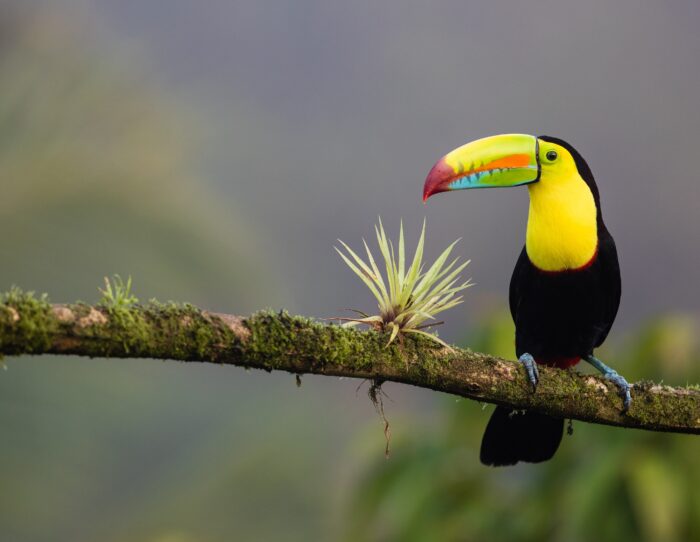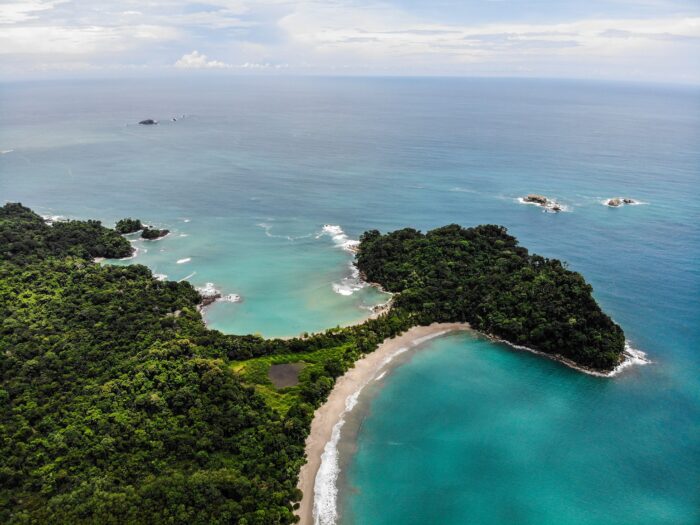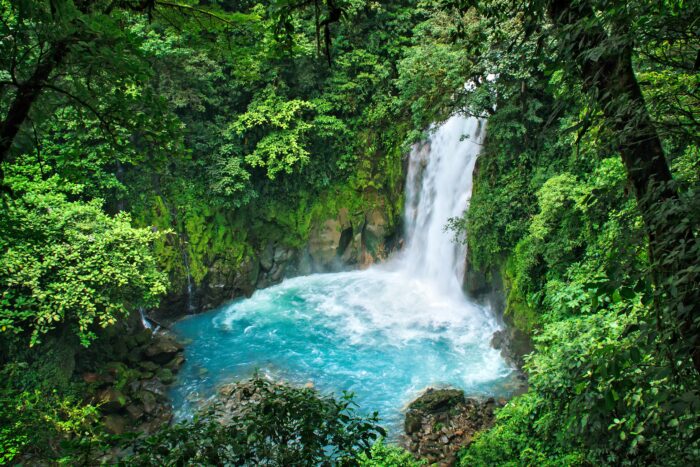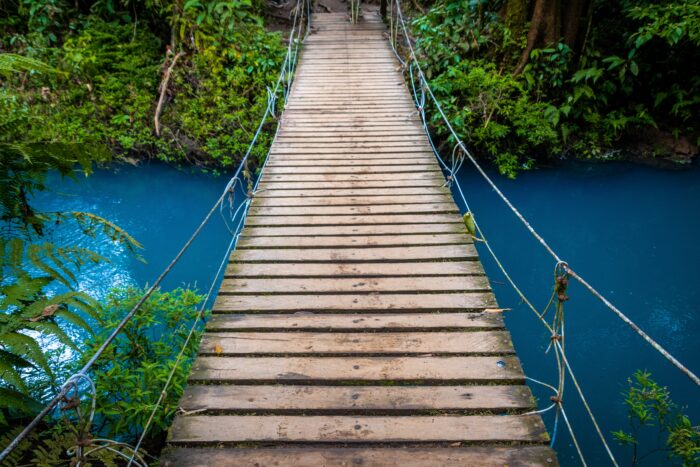Move to Costa Rica
Dreaming of beautiful beaches, tropical weather and a laidback lifestyle? Or maybe you prefer a volcano view with toucans frequently visiting your front lawn? From busy beach towns to homes nestled away in nature, you can have it all as an American living in Costa Rica.

Costa Rica is slightly smaller than the state of West Virginia but it is home to 6% of the world’s biodiversity! Each microclimate offers something different, with mountains, cloud forests, volcanoes, and coastline all within a few hours drive. If you’re thinking of moving to Central or South America, why not consider moving to Costa Rica?
Costa Rica for expats
“Pura vida.” It’s a phrase you’ll hear daily in Costa Rica. While it translates literally to “pure life,” what it really means is a bit more abstract. It’s good morning, how are you, everything is great, and more all rolled into one phrase. Perhaps the most fitting translation is Relax, don’t worry, be happy. And that’s exactly the lifestyle you’ll find when you move to Costa Rica. Nothing happens in a hurry—or even on time. If someone says they’ll be somewhere at 2pm, they might show up by 3pm. Service is slower, no one seems to ever be in a rush or stressed and there’s always time for the beach.
Coming from the go-go-go American lifestyle, the adjustment to the pura vida lifestyle can be a bit of a shock. Realizing that yes, you can take the time to go to the beach and no, that urgent thing is really not so urgent. Things still get done—just not on your timeline.
While this laidback lifestyle can be found in other parts of the world, what sets Costa Rica apart is the level of safety and modern amenities, like A/C, hot water, and decent roads. In areas like Playas del Coco, Tamarindo, Manuel Antonio, Jaco, and the Central Valley you’ll be minutes away from private hospitals and doctors, grocery stores with your favorite American brands, and gated condo communities.
A move to Costa Rica is the best of both worlds, with a slow and relaxed lifestyle while still keeping many of the amenities of home.
How to move to Costa Rica from USA
For those looking to move to Costa Rica from the U.S. there are several options for visas that will allow you to stay in Costa Rica long-term without having to make visa runs every three months. The most popular expat visas in Costa Rica are:
- Pensionado. This is known as the “retiree” visa. Anyone who has a guaranteed income of $1,000 via a pension, social security, or other retirement plan is eligible for this visa. This is an annual visa that can be renewed for 3 years, after which time you can seek permanent residency.
- Rentista. This is the most common visa for anyone under retirement age. To be eligible you must have proof of $2,500 unearned income per month. That includes things like social security, disability, dividends from stocks, rental income, bonds, etc. Tips and your salary do NOT count towards unearned income. Having $60,000 in savings can also help you get this visa, if you can provide a letter from a financial institution showing a balance and set up a $2,500 monthly deposit into a Costa Rican account. Like the pensionado, this visa is temporary for at least 3 years but you can then apply for permanent residency.
- Digital nomad visa. After years of talk, the digital nomad visa was finally signed into law by the President! If you are employed by a country abroad and earn $3,000 a month you are eligible for the digital nomad visa. This visa allows you to stay in Costa Rica for up to 2 years and includes some tax benefits. However, it cannot be extended or turned into permanent residency.
Cost of living in Costa Rica
The cost of living in Costa Rica varies widely just as it does in the United States. Popular tourist towns near the beaches are much pricier than the Central Valley or smaller towns along the coast.
In general, for a studio or one-bedroom apartment you are looking at anything from $400 for a simple place in the mountains (perhaps without hot water or air conditioning) to $1500 for an upscale apartment in beach communities like Jaco or Playas del Coco.

Electricity is another variable expense always paid by the renter and can range from $20 to $200, depending on how often you run the A/C.
Public transportation consists of taxis in towns and buses run across the country. You can get from the capital of San Jose to a beach town on either coast for under $15 and short errands in town typically cost $5 or less by taxi.
Food is on par with small city U.S. prices and you can expect to pay $10 to $20 for lunch at pretty much any restaurant. Local beer is $3-4 while an imported Heineken will cost about $6.
Is Costa Rica safe to live?
Costa Rica is one of the safest countries in Central America, with a democratic government. In 1949, Costa Rica abolished their military and instead directed those funds toward education. Today, the country has a low level of crime and the majority of crime that does occur is petty, opportunity-based crime.
The obvious precautions still exist, of course. Do not leave any valuables in your car or on the beach. Avoid walking the beach at night and its best to take a taxi around town at night. Ask those who have been living in your specific town if there are any areas to avoid after dark—there aren’t many but places like Jaco do have some streets that can become a bit seedy. Others, like Coco, are safe at pretty much any time.
Pickpocketing is common in tourist areas so always keep a close eye on your purse at restaurants and always lock your doors and windows at home as well. Outside of standard precautions, safety is not much of a concern.
Best Places to live in Costa Rica
Perhaps the hardest part of moving to Costa Rica is deciding where to live. There are so many micro-climates, from tropical beaches to rainforests and cloud forests to mountains and volcanoes, that it can be difficult to decide. While there’s not really a wrong place to settle down, there are several areas that already have a thriving expat community.

Atenas
Located in the Central Valley, just 30 minutes from the capital, San Jose, and an hour and a half from Jaco and other beaches, Atenas is a prime contender for those who wish to live a quiet but modern life in the mountains. You’ll find easy access to some of the best hospitals in the country, PriceSmart (think Costco), and other amenities that you won’t find in other parts of the country. Plus the weather is cooler—cool enough you may not even need the A/C.
Playas del Coco
Located just 30 minutes from the Liberia airport, Playas del Coco is one of the biggest beach towns in Guanacaste with a growing expat population. Its proximity to Liberia makes it a good choice for those who want to be close to a private hospital and stores like Walmart and PriceSmart; given that, the town itself is quite small and laidback. From here you’re within minutes drive (or boat ride) from the best beaches in the country and accommodation varies from condos in gated communities to simple, small homes on the side streets.
Jaco
If you want the beach life and nightlife at the same time Jaco may be a better option for you. Jaco is known for being one of the biggest party towns in Costa Rica but also has a booming expat community with plenty of condo complexes and communities. There’s a wide variety of restaurants and you’re just 90-minutes from San Jose. Some of the best surfing beaches are just a short drive away as well—and sometimes you can surf right in Jaco!
Costa Rica health insurance
Costa Rica has a public health system (caja) that covers doctors visitors, emergency care at the public hospitals, medication, and more. Expats with temporary residency via the pensionado or rentista visas do have access to this system as making monthly caja payments is part of the visa requirement. The monthly payment is based on monthly income but is typically around $135 for a pensionado and $348 for a rentista.
While the caja system does provide quality care, like any socialized health system it can also mean long wait times to get in to see any specialist or doctor. For that reason many expats opt to visit private doctors and hospitals instead. On the private system the price varies greatly on where you are and what type of doctor you’re seeing but most visits will cost $50 to $100. However, before you head to the doctor, head to the pharmacy first. Most medications are available over the counter and some pharmacies have a doctor on call to write prescriptions as well.
Another bonus? Costa Rica is famous for dental tourism. Expect a tooth cleaning to be around $60 and other dental services to be just a fraction of what you’d expect in the U.S.
Living in Costa Rica pros and cons
If you’re considering a move to Costa Rica, it’s important to be aware of both the positives and the challenges of living here.
Pros of living in Costa Rica:
- Getting a visa is quite easy and not overly expensive
- There is an ever-expanding international community with almost 20,000 American expats
- Lots of modern amenities and comforts from home
- English is widely spoken in the tourist towns—though learning Spanish is always recommended!
- It’s a short and inexpensive flight away from much of the U.S.

Cons of living in Costa Rica
- It’s not always a cheap country to live in. Monthly expenses can quickly add up!
- The “pura vida” lifestyle can be a little tooooo relaxed at times
- You can expect to wait a while to see a doctor via the public health system
Overall, the positives far outweigh the negatives of living in Costa Rica!
Living in Costa Rica as an American
Living in Costa Rica for 5 years was not my original plan. In fact, I first visited on a 3-month tourist visa and expected to move on to another country. Instead, I fell in love with the beach town of Playas del Coco. There seemed to be no good reason to give up my 2-block walk to the beach every morning (often passing a troop of howler monkeys on the way) or the growing sense of community I felt among the other expats. I quickly discovered my favorite restaurants, cafes, and bars and there was rarely a day I could walk down the main street without a friend waving me down to join them.
After renewing my tourist visa a few times with weekend trips to Nicaragua, I accepted that Costa Rica was my new home and began pursuing a rentista visa. As I was nowhere near retirement, this was really my only option. Unfortunately, after I began the process of getting documents apostilled and fingerprints from the FBI, the pandemic hit and everything paused. Luckily, Costa Rica extended tourist visas for anyone who had been in the country when the pandemic began for almost two years, so I was able to stay without the stress.
Since I would need to redo all of the documentation I had previously started, I’m now applying for the digital nomad visa which thankfully was just signed into law.
Moving to Costa Rica
Making the move to Costa Rica—or any country—is a big decision. But with the availability of temporary residency visas, great infrastructure, and some of the most beautiful beaches in the world, Costa Rica makes the decision a little easier. If you’re still unsure, test it out by taking advantage of their 3 month tourist visa before committing to a longer timeframe. But be prepared, the pura vida lifestyle is quite addictive.





1 thought on “The Ultimate Guide to Living in Costa Rica as an American”
Thank you so much for this article! My husband and I are in the process of working out our move to Coco Beach! I love your take on everything!